Oils and ZDDP Added March 2009
For a couple of years or so I've seen a certain group of people banging on about zinc dithiophosphate (ZDDP) in oils and how a reduction of levels of this additive in modern oils will damage your engine. An apparently clear case of modern versions of something
But first a digression into viscosities and how they have changed over the years. I'm old enough to remember when GTX came out, but turned my nose up at it as the 'GT' label was being stuck on anything and everything at the time, most of it cheap and tacky. But eventually it 'got its knees brown' and had been around long enough, as well as being more readily available it seemed to me, so I started using it. Originally 20W-50, probably some time in the 80s or early 90s it changed to 15W-50 which was obviously an improvement. Come the late 90s or early 2000s it changed again, but this time to 15W-40 - not so good. I immediately noticed a drop in hot idle oil pressure in the V8, which is low enough to begin with, although no change in the roadster. Unhappy about this I started using Halfords 'red can' in the V8 which was 15W-50, and as I couldn't see the point of spending the higher amount on GTX for the roadster switched that as well. But in the last couple of years Halfords have dropped the 15W-50 'red can', the next available grade also being 15W-40 - back to square one. They do however have a 20W-50 'Classic' oil (that comes in a 'proper' metal can to boot). I did buy that last year, but was concerned to find the screw cap had no seal on it, so technically anyone could put anything in it (subsequently I realised the 'seal' was coming off with the screw-cap on those cans, but they have now adopted a plastic pull-up spout with a ring-pull cap that is torn away from the spout). As yet another digression and while researching this topic I came across people recommending buying Mobil 1 loose from Sh*t-Fit, taking their own cans. When others expressed concern about the potential for contamination, if not being sold something completely different, a couple of people stated that they had contacted Mobil who confirmed that they did indeed supply their oil loose to Sh*t-Fit. So they might, but what guarantee have you or Mobil got that some Sh*t-Fit scum-bag hasn't padded it out with something else? The same thing used to concern me many years ago when petrol stations had oil dispensers on the forecourt - you cranked a handle and dispensed it into a small can, then poured it into your engine. Then the can went back on the shelf to gather more dust and flies ready for the next customer! Some people used to insist on bottled oil, but all the garage did was use the same system for filling the bottles! But back to the subject.
So I'm not keen on Halfords Classic 20W-50 because of it being unsealed (I subsequently discover that all the cans come with a plastic insert but it's hit and miss when removing the cap as to whether it stays in the can or in the cap!), there doesn't seem to be any other 20W-50 readily available locally. Then in this month's Enjoying MG MGOC are advertising Castrol XL 20W-50 and recommending it for its higher levels of ZDDP (but see below), so maybe I ought to look into this ZDDP thing after all. Is there something in it? Or is Roche simply repeating what he has seen elsewhere, like he did with his "you will ruin a battery by storing it on a concrete floor" comment of a year or so ago (some years ago someone posted on an MG mailing list "Don't store batteries on concrete floors or you will ruin them". There then followed a long and heated debate about just what physics might or might or might not be involved in causing a concrete floor to damage the internals of a battery, which again I didn't get involved in as it seemed like rubbish to me. A couple of weeks later the original poster came back and said "No no no, I meant that if you put an old battery on a concrete floor and it leaks it will ruin the concrete!" Oh, how I laughed!).
The gist of a number of articles I have read is that yes, ZDDP is necessary to 'cushion' certain sliding components, and the flat tappets and camshaft lobes of our engines seem particularly prone to wear without it, new cams and tappets failing in as little as a few hundred miles. A progressive reduction in zinc (and other additives) has been required by environmental agencies over recent years both to reduce pollution and because they can reduce the life of catalytic converters. The American Petroleum Institute (API) grades oils into 'service categories' and containers are labelled with (amongst other things) 'API' followed 'SA' to 'SM' for petrol and 'CA' to 'CI4' for diesel according to oil formulation and performance. SA to SH are obsolete (our engines originally used SB, SC, SD and SE), as are CA to CE. Originally each new formulation was an improvement and backwards compatible, until it comes to SL which is where the reduction in zinc and other additives started happening. The European equivalent of the API is the ACEA (Association des Constructeurs Europeens d'Automobiles, or European Automobile Manufacturers Association). They have their own way of grading oils which seems much more complicated than the API with class, category and year indicators so I'll stick with the API ratings.
The recommendations I have managed to glean are:
- MGOC Castrol XL20W-50 20 litre drum at £96 delivered, but needs rather a lot of space, and you have to consider storage life and conditions, I've read five years maximum and frost free. They also have 4.5L cans at £29, plus postage. They are rated API SE/CC so suitable for our engines, but don't have the benefits of the later SF to SJ formulations.
- Halfords Classic 20W-50 is also API SE/CC, £17 per five litres i.e. a bit more than a gallon so comparable to the MGOC bulk price without the storage issues. Personally I'm not happy about the unsealed cap though. I subsequently discover that all the cans come with a plastic insert but it's hit and miss when removing the cap as to whether it stays in the can or in the cap!
- A fellow MG-er has some old-stock Unipart Green 20W-50 (part no. GUL7005) that is rated at API SF/CL and so also suitable. Only two places seem to stock it online - Rimmer Bros at £14 and mini spares at £13. No indication of API rating on either site, so check first, although it does seem that where you can still get 20W-50 in various brands they are to SJ or earlier ratings and so suitable.
- The Mini supplier of the above makes me think of Min-Its locally to me, and sure enough they do stock 20W50 but it's Valvoline VR1, at API SL and £19. I certainly don't want to muck about with mail order, so it's a toss-up between Halfords Enhanced Diesel SJ 15W40 or Valvoline SL 20W50, and I opt for the latter (subsequently rejected).
- January 2012: Comma Sonic (NLA) at API SL CF is claimed to have about 0.2% each of Phosphorus and Zinc, which is typically double compared to most of what I have found so far. Note Comma Classic (API SE CC) has less than half this and looks to be in the same cans as Halfords Classic.
December 2017: Not much to add: Comma X-Flow type SP, the datasheet for which specifies API SL CF and Zinc 0.11% Calcium 0.30% Phosphorus 0.10%. Millers Classic Sport 20W/50 now states SPI SL/CF but the only statement about ZDDP is "It is formulated with full ZDDP (zinc phosphorus) for ultimate protection" which could mean anything. A couple of sources for Comma found by Googling, and rather cheap at £14 for 4L, whereas 5L of Millers from Opie Oils is £38! Beware Comma Classic 20W/50 which despite being API SE CC only has 0.08% zinc and 0.07% phosphorus. Ditto Castrol Classic XL 20W/50 API SE/CC which only has 0.08% 'Zinc as ZDDP' i.e. the same as modern oils and no mention of phosphorus.
March 2015: I've got Comma Sonic 20W/50 in both cars at the moment but have been a little concerned about the very slow rise time in the V8 over winter so was hoping to change to a 15W/40 to API SJ, but have not been able to find any. Note that Halfords 15W-40 enhanced Diesel oil is now labelled Mineral Petrol and Diesel Oil rated ACEA A3/B3 and API SL i.e. no longer SJ, however it still has the same CF/CF-4 diesel rating as previously. It's made by Comma and they were able to tell me that it contains 0.11% Zinc, 0.1% Phosphorus, and 0.3% Calcium. Also Comma Sonic is no longer produced, the replacement being Comma X-Flow type SP. This is also SL with the same zinc and phosphorus as Halfords Mineral Petrol and Diesel Oil, but only 4 litres. Millers Classic Sport 20W/50 is still SJ, with 1250ppm or 0.125% ZDDP, so about the same as the Halfords and Comma SLs i.e. not as much as Comma Sonic used to be. I suspect environmental regulation has ordered the reduction.
January 2012: As well as coming across the reference to Comma Sonic the Peter Donlan subsequently wrote saying he is now using ZDDPlus stocked by Frost in a new engine. At the same time Peter Burgess has also mentioned he uses Zincoat from Chemodex. As they are both subject to UK law on claims, I'm hoping the products 'do no harm' at least.
September 2011: A cautionary tale. A pal has had to have his engine rebuilt after only 20k, cams and followers pitted and worn were the main problem. He has his car serviced by a local classic specialist (it was previously restored by them), subsequently enquired what oil they used, and was told it was a semi-synthetic 10W/40 to API SL. The garage wasn't aware of ZDDP issues (nor apparently interested when told), so said pal is replacing it with Halfords Classic (20W/50 API SE). As this tends to confirm problems with SL (and hence SM), especially with newly rebuilt engines, I shall definitely steer clear of it in future. I have recently read that previous use of earlier formulations protects the cams and followers to some extent if changing to SL, but only seen one reference to that, and the writer may be getting it confused with 'lead memory effect' for valves and seats with the change from leaded to unleaded petrol. After a couple of years using Valvoline VR1 (20W/50 API SL) in the V8 I did think it had become a bit noisier, and one contained noticeably less than 5 litres, so had already stopped using it anyway. This spring I got a couple of 5L cans of Unipart Mineral 20W/50 API SF at £17 each, used one and shall keep one for next year, then try to stay one or two cans ahead. Failing that Halfords Enhanced Diesel (15W/40 API SJ). Classic Oils is advertising a number of classic mineral 20W/50 oils, all (bar three where there is no API formulation specified) at API SF and SG. They also have Penrite running-in oil which should be used for the first 300 miles to bed in the rings and bores on a newly rebuilt engine.
August 2009: After a bit of effort I got some data sheets from Halfords. These confirm they are made by Comma, but also contain some down-right confusing information on ZDDP content. For the Classic 20W/50 under hazardous ingredients it states ZDDP at <1% i.e. less than 1%. Fair enough for Elf and safety info, but of no use to us as other product information quotes ZDDP constituents at much less than this, typically less than 0.1%. But then looking at every other Halfords oil, including full synthetic and enhanced mineral diesel, which have very different API classifications, they all specify between 1 and 10%! I.e. anywhere from 10 to 100 times the amount needed!!
Given the amount of web site and mail list chatter about the loss of ZDDP you would think that plenty of additives would be available given the number there are for other engine, gearbox, petrol etc. situations. But I can only find references to one, made in America, and reputedly only one eBay supplier of that in the UK. As there are no warranties as to how effective it is, or more importantly that it won't wreck your engine even faster than having no ZDDP in your oil, I'll leave you to find it for yourselves.
May 2009: Came across a page from LN Engineering and Charles Navarro (who he?). A loooong article (120k of pure text) entitled 'What motor oil is best for my air-cooled Porsche' but is largely relevant to our engines. He concurs with much of the above, but states that there is no evidence of Porsche catalytic converters suffering from the higher levels of zinc and phosphorus in earlier formulations for motor car engines, although he also says motorcycle oils are usually SG, SH or SJ with excellent anti-wear characteristics but will kill catalytic converters. He states that Zn and P (ZDDP) levels of 0.12% (1200ppm) for normal drain intervals, 1450ppm for extended drain intervals are ideal. Comparing wear he states increasing ZDDP from .03% to .05% in an engine with 180lb valve springs reduced wear by 90%! With 205lb springs increasing from .05% to .095% similarly reduced wear by 90%. He gives the following table of additive averages in a range of oils tested or examined, but unfortunately doesn't say what the oils are:
| API | P (ppm) | Zn (ppm) | B (ppm) | Mo (ppm) | Ca (ppm) | Mg (ppm) | Na (ppm) | Total Detergents |
| SE-SJ | 1301 | 1280 | 151 | 357 | 1936 | 293 | 214 | 2443 |
| CI-4 | 1150 | 1374 | 83 | 80 | 2642 | 199 | 2840 | |
| SL | 994 | 1182 | 133 | 273 | 2347 | 109 | 22 | 2479 |
| CJ-4 | 819 | 1014 | 26 | 2075 | 7 | 2082 | ||
| SM | 770 | 939 | 127 | 122 | 2135 | 13 | 139 | 2287 |
I found a set of Castrol UK product data sheets (click on 'View Complete Technical Data Sheet List") which make interesting reading. Amongst the many products the following levels of zinc and phosphorus are specified:
| Product | ACEA | API | Zinc | Phosphorus |
| Classic XL 20W-50 | SE/CC | 0.08 | ||
| Classic XL 30 | SB | 0.084 | 0.077 | |
| GTX 15W-40 | A3/B3 | SL/CF | 0.1035 | 0.093 |
| GTX High Mileage 15W-40 | A3/B3 | SL/CF | 0.1035 | 0.093 |
| GTX Professional 5W-30 | A1/B1 | SL | 0.099 | 0.091 |
| GTX Professional 10W-40 | A3/B3 | SL/CF | 0.0933 | 0.091 |
Castrol products for the USA are very different and product data sheets are listed here (click on "View all Product data Sheets). For all GTX standard and high-mileage viscosities whilst there are entries for zinc and phosphorus in the tables there are no values shown. For the Syntec products there aren't even any entries. GTX Diesel 15W-40 has 0.13 and 0.11 respectively, and 'GRAND PRIX MOTORCYCLE 4-STROKE' products have 0.11 and 0.10 respectively.
I did a similar search on Mobil UK product data sheets. Some like Mobil 1 Fuel Economy 0W-30 quote 0.10 phosphorus, Syst S Special V 5W-30 0.08, Super 3000 XE 5W-30 0.08, Synt S 5W-40 0.09, Mobil 1 0W-40 0.10, Super 3000 Formula R 5W-30 0.05, SHC Formula V 5W-30 0.08, Super FE Special 5W-30 0.10, LL Special G 5W-30 0.09, SHC Formula MB 0.08, Syst S ESP 5W-30 0.08. No entries for zinc entries, and the remainder of the Mobil products either didn't have phosphorus entries or they were blank.
References:
http://www.opieoils.co.uk/pdfs/Is-there-a-flat-tappet-issue.doc - flat-tappet issues.
http://motorcycleinfo.calsci.com/API.html - API Service Categories.
http://lukoil-lubricants.com/info/classification/00007/ - ACEA and API classifications.
Castrol UK product data sheets.
Castrol US product data sheets.
Mobil product data sheets.
Valvoline Racing VR1 product data sheet.
Mixing and switching between mineral, semi-synthetic and synthetic oils.
Filter types and quality
Filter not sealing
Oil Pump
Oil Pressure Relief Valve
Block Adapter
Decals
The 1977 LHD Workshop Manual AKM3524 gives the bypass valve opening pressure as 13 to 17 psi. Note that this is the pressure differential between the input and the output. On cold starts with thick oil this pressure can be exceeded, which can lead to holes being punched through the filtration medium. Note that some filters do not have a bypass valve.
The various styles of filter and head used over the years:
| Engine | Dates | Head | Filter | Notes |
| 18G, GA | All | 8G740 | 1H1069 | Teclamit suspended replaceable element |
| 18G, GA | All | 1H1052 | 1H1053 | Purolator suspended replaceable element |
| 18GB | Oct 64 - Nov 67 | 8G740 | 1H1069 | Teclamit suspended replaceable element |
| 18GD, GF, GG, GH | Nov 67 - Apr 70 | 12H2244 | 12H2258 | Teclamit Inverted replaceable element |
| 18GG, GH, GJ, GK 18V 581, 582, 583 18V 672, 673 | Mar 70 - Sep 73 | 12H3273 | GFE114 | Inverted spin-on cartridge |
| 18V 581, 582, 583 18V 672, 673 18V 779, 780 | Oct 73 - Jan 74 | 12H4405 | GFE148 | Suspended spin-on cartridge, see Note below |
| 18V 836, 837 18V 846, 847 18V 797, 798 18V 801, 802 18V 883, 884 18V 890 - 893 | Feb 74 on | 12H3273 | GFE114 | Inverted spin-on cartridge |
After trying various makes over the years my preferred filter is the Mann W916/1. Available from loads of online sources at anything from under £3 to more than £15, but for the cheaper ones check for VAT and P&P. At the moment (September 2019) Car Parts 4 Less have them at £4.06 including VAT and free delivery.
The Parts Catalogue quotes GFE114 for both the 4-cylinder inverted and the V8 hanging. Looking at equivalents for that Mann W920/21 is amongst more than 50 different types, and I know Mann have online specifications for many if not all of their filters. Looking at W920/21 - within one basic type there can be many /suffixes covering things like thread, bypass valve pressure and how many anti-drain-back valves are fitted - and W916/1 is close to W920/21 in all those areas, with the Imperial thread, so I'm happy using that on both cars. The 4-cylinder hanging is specified as GFE148 which has a smaller overall diameter and is shorter than the others, implying perhaps less filtration medium, but maybe there are space limitations.
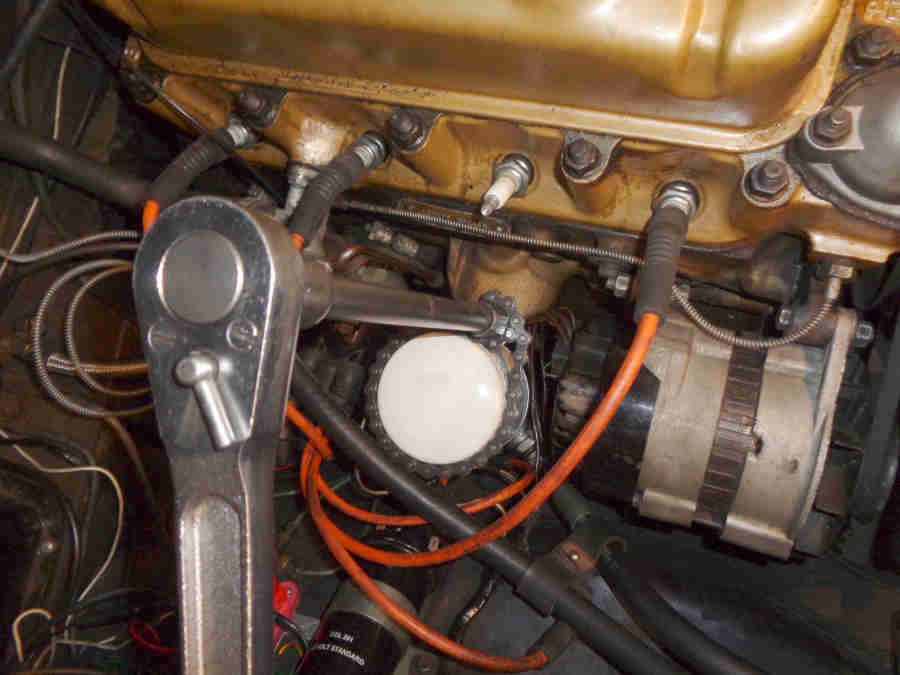 Limited access with the later inverted canister type, definitely needs a tool. Several types - the type with a strap and handle are not really suitable as there is so little space to swing the handle. I've been using a Halfords chain type which uses a socket wrench and long extension for as long as I've had a car - 55 years. The only problem I had was on a 1500 Midget where I couldn't get even that square onto the filter and the chain broke - easily fixed with a repair link. Similar types with a fabric strap (cheaper), and yet others with three legs that clamp onto the end of the filter but they are more than double the price of the chain/strap type and still need a socket wrench and extension.
Limited access with the later inverted canister type, definitely needs a tool. Several types - the type with a strap and handle are not really suitable as there is so little space to swing the handle. I've been using a Halfords chain type which uses a socket wrench and long extension for as long as I've had a car - 55 years. The only problem I had was on a 1500 Midget where I couldn't get even that square onto the filter and the chain broke - easily fixed with a repair link. Similar types with a fabric strap (cheaper), and yet others with three legs that clamp onto the end of the filter but they are more than double the price of the chain/strap type and still need a socket wrench and extension.
Care is needed screwing one back on! On the inverted at least the adapter thread is not quite vertical, and it's very easy to cross-thread.
In response to a query about owner conversion to suspended I had to say that from my own experiences with one inverted and two hanging filters I can say for sure that I prefer the inverted! When removing a hanging filter (V8 and ZS) as soon as the seal moves away from the filter head oil starts running down the outside of the canister, and wearing gloves to protect myself from hot oil there is no purchase whatsoever, even though the filter is spinning freely by that time. I have to have sheets of paper to hand to grip it with, which are better than the gloves but still slip and it takes a significant time to get it off altogether. And all the time I'm doing it oil is dripping off the bottom, so I have to have the same 'nappy' of several thicknesses of newspaper underneath it (V8) to catch it. Bad enough on the V8 which is at least tackled from above, but on the ZS which is removed from below the oil is running up my arms as well! At least I can position a bucket under that to catch what is running off, just using masking tape wrapped round the filter for grip. With the inverted on the roadster I position the newspaper underneath formed into a shallow bowl same as for the V8, and once slackened can spin the old filter off and get it 'right way up' much quicker and easier than with the other two.
 Inverted spin-on filters need an anti-drainback valve to prevent the filter from emptying when the engine is switched off, which delays oil reaching the bearings on start-up. Not needed on hanging filters, but I'd expect all good spin-ons (i.e. the Mann 916/1) to have them as a matter of course. However not all do, and some are very poor quality.
Inverted spin-on filters need an anti-drainback valve to prevent the filter from emptying when the engine is switched off, which delays oil reaching the bearings on start-up. Not needed on hanging filters, but I'd expect all good spin-ons (i.e. the Mann 916/1) to have them as a matter of course. However not all do, and some are very poor quality.
For years I used Unipart, Champion or Halfords and had no cause for concern. Then someone posted that after a recent oil change, pressure was taking much longer to build (not just on the first start but subsequently) than before, even when the engine had been off only a matter of hours. So he unscrewed the new filter and was surprised to find no oil flooded out as is usual with the inverted cartridge filters. Thinking he had a bad filter with a faulty non-return valve he fitted a new filter, only to find the same thing happened. I'm pretty sure he had this problem with Unipart and Champion, and I can't remember the final outcome (or even if one was posted). I continued to use filters as before but kept a closer eye on pressure rise than hithertofore, but noticed no change. As I change my oil and filters hot I also continued to find the filters full of oil on removal, however the last Champion 102 I bought does not have an anti-drainback valve. One thing to bear in mind that when starting a 4-cylinder engine daily pressure rise should be practically instantaneous. Only if left for a week or more should it take a few seconds to rise, which it will do more slowly, but should still only take around 6 to 10 secs. for full pressure. V8s are renowned for their very slow start and rise times, after just a few hours, but this is because of having twice the number of cylinders i.e. bearings plus hydraulic tappets. Early V8s had the gauge tapping on the filter outlet, moved to the oil pump in December 73 on car number 1149 "for improved reading on pressure gauge when starting engine", which is what mine has, I dread to think how slow it must have been before. I've tried an alternative gauge with larger bore plastic tubing compared to the copper capillary, but it made little difference, neither does bleeding the capillary compared to having it full of air. It's just a factor of the engine.
To get back to filters, my interest was now piqued, and doing some internet research came across Russ Knize's Oil Filter Study (this is an edited version, the original has gone) which goes into quite a bit of detail about filter construction, albeit of American filters, which shows that the type and quality of materials and construction used can vary quite a bit, anti drain-back and relief valve included. However that is dated 2000, and I subsequently found a more comprehensive 2008 version here. Why the old one has been left unchanged I don't know, but there it is. At the same time a well-known source started advertising filters with 'an improved anti drain-back valve' so I bought some in 2005. Part number GFE121F they turned out to be Fram filters PH2857A. Fram make a number of different 'grades' and some don't get a very good write-up. Even worse, when fitting one to the roadster I found the pressure rise time was longer than with the Halfords and Champion, so I kept them back for the V8 which uses the same filter but hanging, and reverted to Champion in 2006. I then came across recommendations for a Volvo filter (3517857-3), made by Mann (W917). As I have a Volvo dealership nearby I bought one in 2007, at £7.64 at the time about 50% dearer than Halfords/Champion. I was pleased to find that these filters gave a shorter rise time which lasted the life of the filter. More listening and watching saw K&N Gold filters get an excellent recommendation. After much research I managed to find somewhere I could order these (HP2004), but it was a trek across Birmingham to collect them in 2008 rather than a pleasant trip down a country lane, and they were 50% dearer than the Volvo i.e. double the price of the Halfords/Champion and four times the price of Unipart! In the event they were no better than the Volvo, so for 2009 it was back to Volvo for the roadster, using Champion for the V8 now I have used up all the Fram.
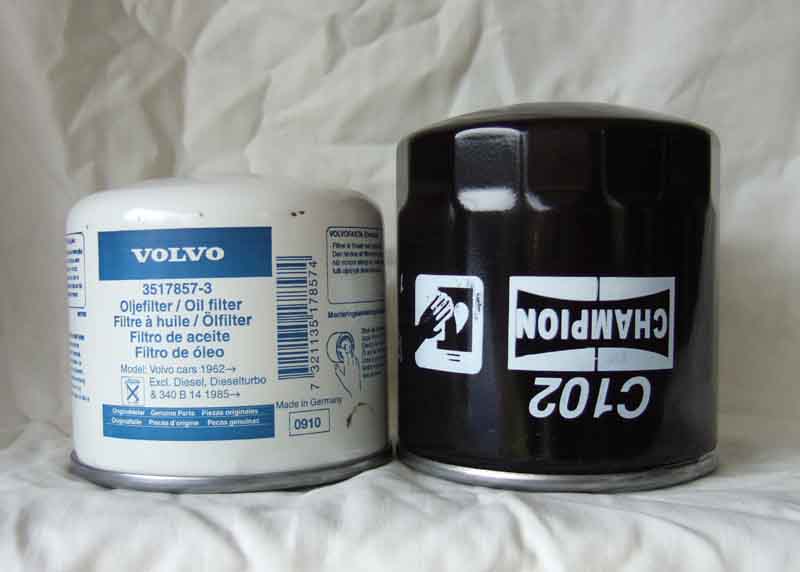 But it was only on purchasing the Volvo filter in 2009 that I noticed it was shorter than the other filters I had been using. I asked if they had been changed but was assured they had not, so I suppose I just didn't notice before. I wasn't particularly bothered by this, until I read something very recently where filter internal depth can be a big issue. There have been several changes in filter head design and orientation over the years, and one of these was to fit an anti drain-back tube to the head that goes up the middle of the filter. This stops oil draining out of the filter via the outlet, as well as the anti drain-back valve in the filter cartridge reducing how quickly oil drains back into the feed pipe. It is absolutely vital that the filter you get is deeper than the length of this tube, and by at least 1/2".
But it was only on purchasing the Volvo filter in 2009 that I noticed it was shorter than the other filters I had been using. I asked if they had been changed but was assured they had not, so I suppose I just didn't notice before. I wasn't particularly bothered by this, until I read something very recently where filter internal depth can be a big issue. There have been several changes in filter head design and orientation over the years, and one of these was to fit an anti drain-back tube to the head that goes up the middle of the filter. This stops oil draining out of the filter via the outlet, as well as the anti drain-back valve in the filter cartridge reducing how quickly oil drains back into the feed pipe. It is absolutely vital that the filter you get is deeper than the length of this tube, and by at least 1/2".
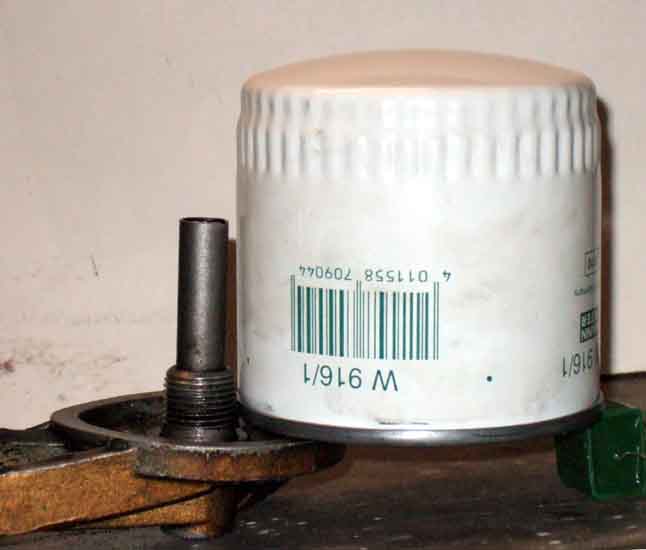 The account I read said the filter was so short it completely blocked the end of the tube, which is the only outlet for oil, the relief valve being inside the filter on cartridge filters unlike the earlier replaceable element type where it was in the filter head. There is a long and boring video (including the Dumb Present Owner filming the running of his engine with no oil pressure!) which demonstrates this using a depth gauge, two filters and a filter head, but you really only need to see these three frames to get the idea. The narrator keeps banging on about the depth of the 'relief valve' but it is the length of the anti drain-back tube and the available depth inside the filter he is measuring of course, which may or may not include a bypass valve. The internal space on the Champion is 2.785", the Volvo is 2.57", and the Mann 917/1 is 2.75" (the last two going inside the bypass valve spring). The Mann 916/1 is 2.93" internally, and the Unipart GFE422/121 is 3.02", these two being the same external height at 3.76". The tube on my filter head is 2" long, and fits inside the bypass valve spring, so plenty of room even for the shorter Volvo and Mann 917/1. Much less difference internally than externally between the Champion and Volvo, i.e. a short filtration cartridge in a long can? Leading you to think you are getting a more effective filter? September 2016: However note that currently the Mann 917/1 as well as being shorter is shown as having a thread of M20 x 1.5, whereas the 916/1 has a thread of 3/4"-16 UNF, i.e. the 917/1 is not an exact equivalent, and I suspect the Volvo 3517857-3 is the same.
The account I read said the filter was so short it completely blocked the end of the tube, which is the only outlet for oil, the relief valve being inside the filter on cartridge filters unlike the earlier replaceable element type where it was in the filter head. There is a long and boring video (including the Dumb Present Owner filming the running of his engine with no oil pressure!) which demonstrates this using a depth gauge, two filters and a filter head, but you really only need to see these three frames to get the idea. The narrator keeps banging on about the depth of the 'relief valve' but it is the length of the anti drain-back tube and the available depth inside the filter he is measuring of course, which may or may not include a bypass valve. The internal space on the Champion is 2.785", the Volvo is 2.57", and the Mann 917/1 is 2.75" (the last two going inside the bypass valve spring). The Mann 916/1 is 2.93" internally, and the Unipart GFE422/121 is 3.02", these two being the same external height at 3.76". The tube on my filter head is 2" long, and fits inside the bypass valve spring, so plenty of room even for the shorter Volvo and Mann 917/1. Much less difference internally than externally between the Champion and Volvo, i.e. a short filtration cartridge in a long can? Leading you to think you are getting a more effective filter? September 2016: However note that currently the Mann 917/1 as well as being shorter is shown as having a thread of M20 x 1.5, whereas the 916/1 has a thread of 3/4"-16 UNF, i.e. the 917/1 is not an exact equivalent, and I suspect the Volvo 3517857-3 is the same.
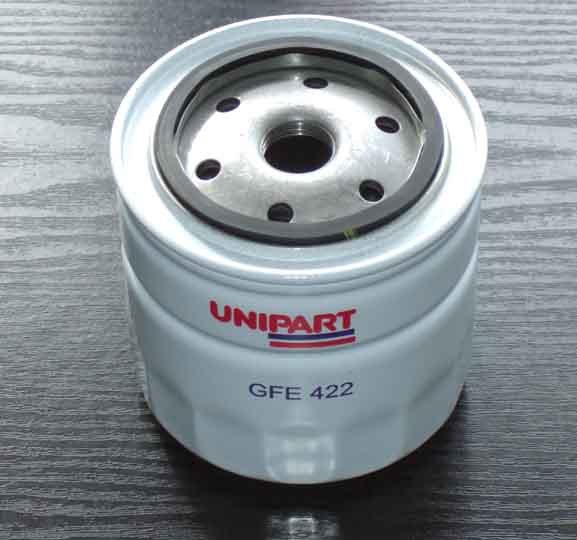 There have been questions about the differences between GFE121 and GFE422. One opinion was that the former had has a magnet on the case but the latter didn't, subsequently debunked by cutting open examples of both, although some filters do seem to have them stuck on the outside. Not sure what effect this has, the can is ferrous, which surely acts as a Faraday cage blocking any magnetism from the inside? Not so, if the magnet is powerful enough it's effects will extend through the metal can. You can get magnetic 'bracelets' to encircle the can, but if you are that concerned you would be better off with a magnetic sump plug and be able to see the effects. Anyway, the GFE422 seems to be a replacement for the 121, being identical, and a parts rationalisation, the two numbers being applied to different applications of the same filter at one point. These are from Unipart, which at just over £3 including VAT are very cheap (worryingly so?) compared to the Halfords/Champion at £5, the Volvo 3517857-3 at £7, and the K&N at £12! Mann W916/1 is a longer version of the Volvo/Mann W917/1, almost as long as Unipart, Champion etc., but I have not been able to find any UK sources from Google, only in mainland Europe. Subsequently Michael Beswick found them stocked by Central Auto Supplies (now Motor Parts Direct) at £2.60 plus VAT (making the others expensive rather than the Unipart cheap), and in November 2014 I find them listed by Halfords at £3.19. March 2019: Halfords now charging £6.26 for the Mann 916/1, and only a week later £8.22! Euro Car Parts have them at £5.89 with free delivery, and at the time of writing a discount code making them £2.94! Bargain.
There have been questions about the differences between GFE121 and GFE422. One opinion was that the former had has a magnet on the case but the latter didn't, subsequently debunked by cutting open examples of both, although some filters do seem to have them stuck on the outside. Not sure what effect this has, the can is ferrous, which surely acts as a Faraday cage blocking any magnetism from the inside? Not so, if the magnet is powerful enough it's effects will extend through the metal can. You can get magnetic 'bracelets' to encircle the can, but if you are that concerned you would be better off with a magnetic sump plug and be able to see the effects. Anyway, the GFE422 seems to be a replacement for the 121, being identical, and a parts rationalisation, the two numbers being applied to different applications of the same filter at one point. These are from Unipart, which at just over £3 including VAT are very cheap (worryingly so?) compared to the Halfords/Champion at £5, the Volvo 3517857-3 at £7, and the K&N at £12! Mann W916/1 is a longer version of the Volvo/Mann W917/1, almost as long as Unipart, Champion etc., but I have not been able to find any UK sources from Google, only in mainland Europe. Subsequently Michael Beswick found them stocked by Central Auto Supplies (now Motor Parts Direct) at £2.60 plus VAT (making the others expensive rather than the Unipart cheap), and in November 2014 I find them listed by Halfords at £3.19. March 2019: Halfords now charging £6.26 for the Mann 916/1, and only a week later £8.22! Euro Car Parts have them at £5.89 with free delivery, and at the time of writing a discount code making them £2.94! Bargain.
A fuller list of equivalents can be found at GermanFilters.com but is reproduced here in case the page vanishes, and a list of specifically Mann equivalents for the Champion C102 and Unipart GFE121/422 filters can be found here.
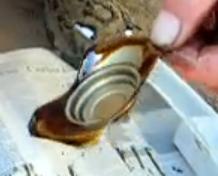 As well as the oil filter study referenced above there are a number of short videos on filter construction here (however don't bother with one titled 'detailed video' as it is nothing more than some idiot taking one out of its box!) and you don't have to see many before you start noticing the different qualities of construction. Several seem to use a very similar 'cartridge' (cellulose/paper with metal end-caps and perforated core), the differences being in the thickness of the case (largely irrelevant) and the quality of the bypass and anti-drainback valves. Some filters don't have a bypass valve at all, just a pressed spring plate which is simply there to seal the centre hole and press the cartridge down onto the base-plate to seal that end. There should be a spring valve as part of this end plate, although some filters are claimed to have the bypass valve as part of the anti-drainback valve, and hence less easily identified. The purpose of the bypass valve is to allow oil to flow if the filter medium should get blocked with dirt, but perhaps more importantly it can also open on cold starts when the oil is very viscous and little flows through the medium. Without this pressure relief as well as lack of oil to the bearings pump pressure could rupture the filter medium, effectively leaving you with no filter at all. The Mann types take about 1 bar or 15psi to bypass, nicely inside the Workshop Manual spec of 13 to 17 psi. Wix (WL7124 for the MGB) seems to come out well, but like the Mann W916/1 don't seem to be available in the UK from a Google search (however a chap at Stoneleigh had a couple of Mann W916/1 at £3 so I bought one, and I won an eBay auction for another at 99p, albeit plus £3 p&p, so I'm OK for a couple of years). June 2011: Nigel in Belfast has written to say that his local motor factors stocks the Mann W916/1.
As well as the oil filter study referenced above there are a number of short videos on filter construction here (however don't bother with one titled 'detailed video' as it is nothing more than some idiot taking one out of its box!) and you don't have to see many before you start noticing the different qualities of construction. Several seem to use a very similar 'cartridge' (cellulose/paper with metal end-caps and perforated core), the differences being in the thickness of the case (largely irrelevant) and the quality of the bypass and anti-drainback valves. Some filters don't have a bypass valve at all, just a pressed spring plate which is simply there to seal the centre hole and press the cartridge down onto the base-plate to seal that end. There should be a spring valve as part of this end plate, although some filters are claimed to have the bypass valve as part of the anti-drainback valve, and hence less easily identified. The purpose of the bypass valve is to allow oil to flow if the filter medium should get blocked with dirt, but perhaps more importantly it can also open on cold starts when the oil is very viscous and little flows through the medium. Without this pressure relief as well as lack of oil to the bearings pump pressure could rupture the filter medium, effectively leaving you with no filter at all. The Mann types take about 1 bar or 15psi to bypass, nicely inside the Workshop Manual spec of 13 to 17 psi. Wix (WL7124 for the MGB) seems to come out well, but like the Mann W916/1 don't seem to be available in the UK from a Google search (however a chap at Stoneleigh had a couple of Mann W916/1 at £3 so I bought one, and I won an eBay auction for another at 99p, albeit plus £3 p&p, so I'm OK for a couple of years). June 2011: Nigel in Belfast has written to say that his local motor factors stocks the Mann W916/1.
Anyone still thinking about using Fram (including GFE121F for the MGB remember!) should watch this - the ends of the filtration medium should be clipped together to form a cylinder such that with (cardboard!) end caps all the oil has to flow through the filter, but only half of the length is held in the clip leaving a dirty (pun intended) great hole for unfiltered oil to flow straight through! Also this which seems to show a collapsed filter cartridge, quite probably from not having a bypass valve. Whilst there seem to be several different grades of Fram the element seems to be common (poor), with only minor differences in the valves (poor to not much better). STP (made by Champion!) are even worse than Fram, having the same cardboard end caps (all the other filters viewed have metal) and no bypass valve at the closed end, but only having a plastic former for the filtration cartridge whereas all the others, even Fram, have a perforated metal tube.
Filters not sealing March 2019:
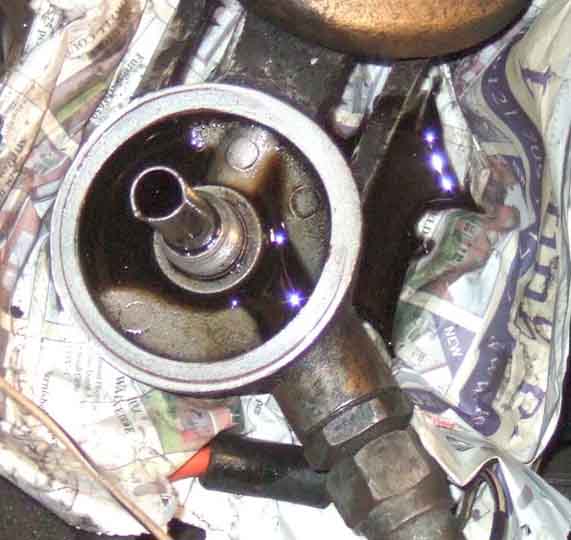 I was beginning to think there must be a problem with the filter head (adapter attached to the block to allow the use of an inverted spin-on canister), even though once sealed there was never a problem until the next service, so got a used one from Welsh MG as a precaution. Again not a problem for the rest of the year, but this year when I removed the filter I cleaned up the sealing surface of the filter head and had a good look at it. And even with my eyes and possible distortion from glasses it immediately looked as if the sealing surface was warped. Smeared some copper grease round the seal of a new filter, wound it on until it just touched, and removed it again. The only grease on the sealing face was at two areas 180 degrees apart from each other, and nothing on the rest. Regreased the seal and fitted the filter again, this time turning it half a turn after contact before removing it again, and this time there is grease round three-quarters of it, but not at the remaining quarter, which is where it has been spurting from. So definitely suspect, and must be changed.
I was beginning to think there must be a problem with the filter head (adapter attached to the block to allow the use of an inverted spin-on canister), even though once sealed there was never a problem until the next service, so got a used one from Welsh MG as a precaution. Again not a problem for the rest of the year, but this year when I removed the filter I cleaned up the sealing surface of the filter head and had a good look at it. And even with my eyes and possible distortion from glasses it immediately looked as if the sealing surface was warped. Smeared some copper grease round the seal of a new filter, wound it on until it just touched, and removed it again. The only grease on the sealing face was at two areas 180 degrees apart from each other, and nothing on the rest. Regreased the seal and fitted the filter again, this time turning it half a turn after contact before removing it again, and this time there is grease round three-quarters of it, but not at the remaining quarter, which is where it has been spurting from. So definitely suspect, and must be changed.
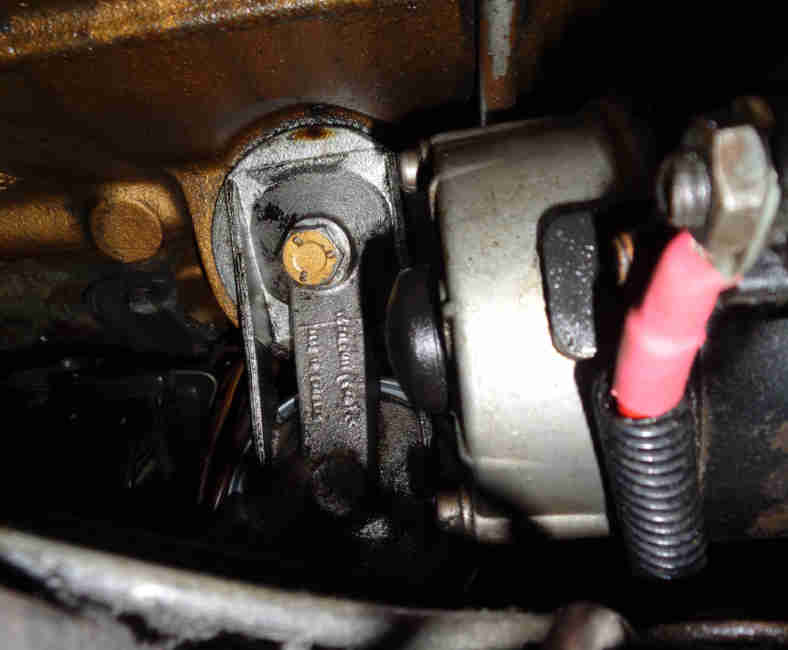 My next concern was how tight the bolt into the block was, after being undisturbed for possibly up to 40 years. I could imagine the bolt shearing, and then what would I do! So got underneath with a long extension on the socket, tentatively applied some pressure to the ratchet handle bearing in mind the brake pipe in the vicinity, and the bolt came undone - it was barely finger tight.
My next concern was how tight the bolt into the block was, after being undisturbed for possibly up to 40 years. I could imagine the bolt shearing, and then what would I do! So got underneath with a long extension on the socket, tentatively applied some pressure to the ratchet handle bearing in mind the brake pipe in the vicinity, and the bolt came undone - it was barely finger tight.
Next possible trauma - the oil cooler hose. An adapter between that and the filter head, with a 9/16" Whitworth hex on the hose connection, and fractionally smaller than that on the adapter. I only have one 9/16 and a Metric spanner which is slightly larger. With the spanner on the hose fitting Sod's Law dictates it is the adapter that comes free first. No big deal, I'm removing the filter head so could unscrew it from the hose. But the 'start' on the new one is quite likely to be in a different place, meaning the cooler hose would be under torsion, and in any case the replacement filter head has its own adapter already fitted. But with the 9/16 on the adapter, and a penny in the jaws of the metric spanner makes that a snug fit on the hose fitting. Squeeze the handles together between my two hands (avoids putting stress on the adapter or filter head) and the hose fitting comes free. Remove that and tie it up out of the way to stop it dripping. With that off and the bolt removed the old filter head comes free with a bit of wiggling.
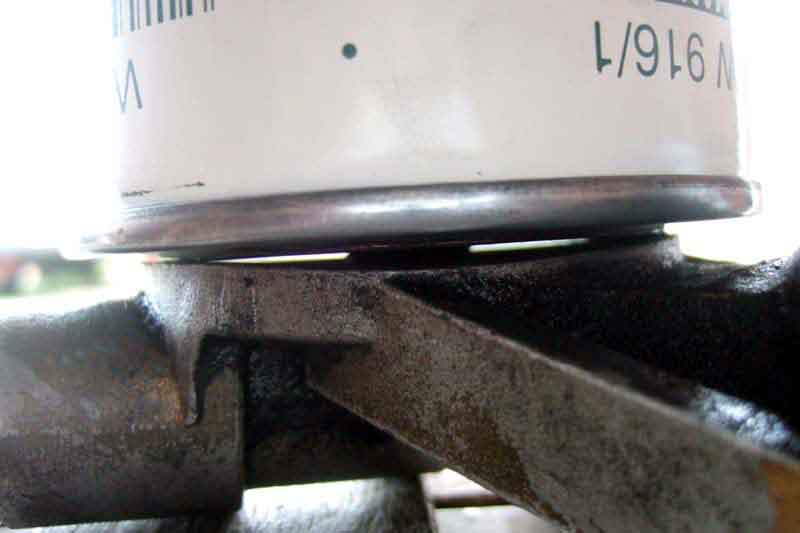 With a new filter screwed on to the old filter head until the seal just touches, there is no-less than 65 thou or 1/16" inch clearance half way between the two places the seal is touching. Even tightened a further half turn there is still 25 thou or 1/32". How did that happen? It's been getting harder and harder to get a seal, so it must have been warping more and more over the years, but how?
With a new filter screwed on to the old filter head until the seal just touches, there is no-less than 65 thou or 1/16" inch clearance half way between the two places the seal is touching. Even tightened a further half turn there is still 25 thou or 1/32". How did that happen? It's been getting harder and harder to get a seal, so it must have been warping more and more over the years, but how?
Any way, check the new filter head with a filter and as soon as it touches it is touching all the way round, so that should solve the problem. For good measure I run a whetstone round the flange that goes up into the groove on the crankcase until that shows clean metal all the way round.
What to do about the sealing ring? It's been in there up to 40 years, and from past experience it can be a beggar digging them out, and there is not much room to get one's arm up to get at the one on the MGB. I poke it with a pointed screwdriver and it still shows some resilience, so opt to leave it in-situ. But for good measure put a smear of flange seal round the lip of the new filter head and bolt up, comparing the angle of the adapter for the oil cooler hose with a photo of the original I took earlier, and fit the hose.
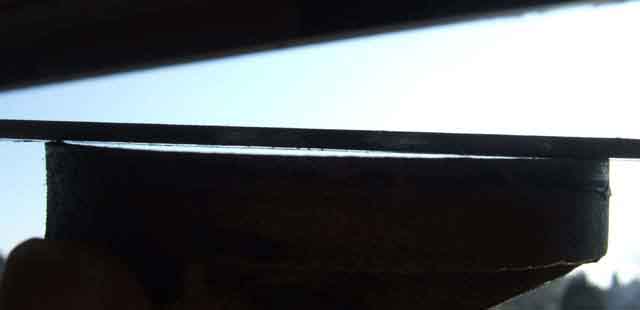 I'd already drained the oil, so refilled it. I'd also decided to take the plugs out, disconnect the coil and crank it on the key first of all in case there was a disaster with oil spurting out all over the place, as that should chuck much less out than an engine on fast idle having to slow and stop. Cranked for a few seconds, looked OK, then cranked again until the oil pressure just started to rise. Still OK from on top, get underneath to see a slight glistening against the crankcase immediately beside where the filter head contacted it. Was that a leak? Or a trace of oil left behind from what leaked out on removal of the old filter head? Replaced the plugs, connected the coil, and fired up. Full oil pressure, and after a few seconds there was a thin line of oil slowly making its way down the side of the crankcase - buggah, should have changed that seal. Nevertheless, running it for ten minutes or more up to full temperature, it had only just reached the flange on the crankcase where the sump attaches, so not major, it will just have to leak like all the others. It was only subsequently when showing a neighbour the warped filter head, when I noticed that the flange that goes up into the groove on the crankcase was like a switch-back! That would have put a set on the seal, making it less likely to seal to a flat surface (the opposite problem of a flat filter seal failing to seal to the warped filter head). Definitely should have changed the seal! Oh well, next time. Next day I thought it was worth tightening the filter head bolt a bit more, as I could feel it tightening onto rubber and not anything solid. Couple more clicks on the socket ratchet, and that together with the old seal quite possibly moving to accommodate the new filter head seems to have stopped the leak - at least I thought it had, but it still weeps a bit, so I shall have to bite the bullet. March 2019: Forgot all about this and no leaks evident since, so left it alone. I didn't change the copper washer on the centre-bolt either, I know people are paranoid about these and re-anneal (soften with heat) at every oil change, but I've never done it on multiple cars over 60 years and not had one leak.
I'd already drained the oil, so refilled it. I'd also decided to take the plugs out, disconnect the coil and crank it on the key first of all in case there was a disaster with oil spurting out all over the place, as that should chuck much less out than an engine on fast idle having to slow and stop. Cranked for a few seconds, looked OK, then cranked again until the oil pressure just started to rise. Still OK from on top, get underneath to see a slight glistening against the crankcase immediately beside where the filter head contacted it. Was that a leak? Or a trace of oil left behind from what leaked out on removal of the old filter head? Replaced the plugs, connected the coil, and fired up. Full oil pressure, and after a few seconds there was a thin line of oil slowly making its way down the side of the crankcase - buggah, should have changed that seal. Nevertheless, running it for ten minutes or more up to full temperature, it had only just reached the flange on the crankcase where the sump attaches, so not major, it will just have to leak like all the others. It was only subsequently when showing a neighbour the warped filter head, when I noticed that the flange that goes up into the groove on the crankcase was like a switch-back! That would have put a set on the seal, making it less likely to seal to a flat surface (the opposite problem of a flat filter seal failing to seal to the warped filter head). Definitely should have changed the seal! Oh well, next time. Next day I thought it was worth tightening the filter head bolt a bit more, as I could feel it tightening onto rubber and not anything solid. Couple more clicks on the socket ratchet, and that together with the old seal quite possibly moving to accommodate the new filter head seems to have stopped the leak - at least I thought it had, but it still weeps a bit, so I shall have to bite the bullet. March 2019: Forgot all about this and no leaks evident since, so left it alone. I didn't change the copper washer on the centre-bolt either, I know people are paranoid about these and re-anneal (soften with heat) at every oil change, but I've never done it on multiple cars over 60 years and not had one leak.
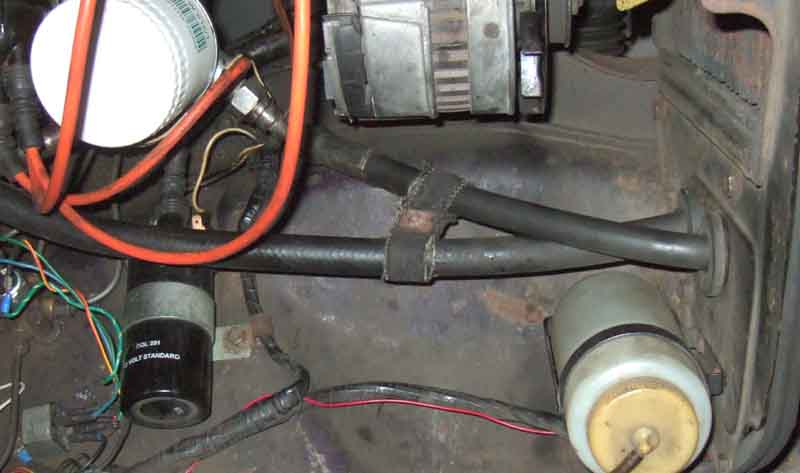 Overnight subconscious pondering also made me realise the cooler hoses go through the wrong holes - the filter head hose is through the upper hole instead of the lower. The strap tying the two hoses together was also very near the filter head. When I went to re-attach the hose to the new filter head I had to push it down quite a bit, when then bent the hose fitting downwards so the threads were nowhere near in line. To bend that back up, while the hose was pushed down, was taking more force that I was prepared to use, so I slid the strap forwards towards the radiator diaphragm which made it much easier to align the threads. It occurs to me that the force I wasn't prepared to use, had been acting upwards on the adapter in the old filter head for anything from 25 to 40 years, in precisely the direction that the filter head had 'bent'. Will I correct the hoses? Probably not until the engine has to come out, or the cooler or hoses replaced.
Overnight subconscious pondering also made me realise the cooler hoses go through the wrong holes - the filter head hose is through the upper hole instead of the lower. The strap tying the two hoses together was also very near the filter head. When I went to re-attach the hose to the new filter head I had to push it down quite a bit, when then bent the hose fitting downwards so the threads were nowhere near in line. To bend that back up, while the hose was pushed down, was taking more force that I was prepared to use, so I slid the strap forwards towards the radiator diaphragm which made it much easier to align the threads. It occurs to me that the force I wasn't prepared to use, had been acting upwards on the adapter in the old filter head for anything from 25 to 40 years, in precisely the direction that the filter head had 'bent'. Will I correct the hoses? Probably not until the engine has to come out, or the cooler or hoses replaced.
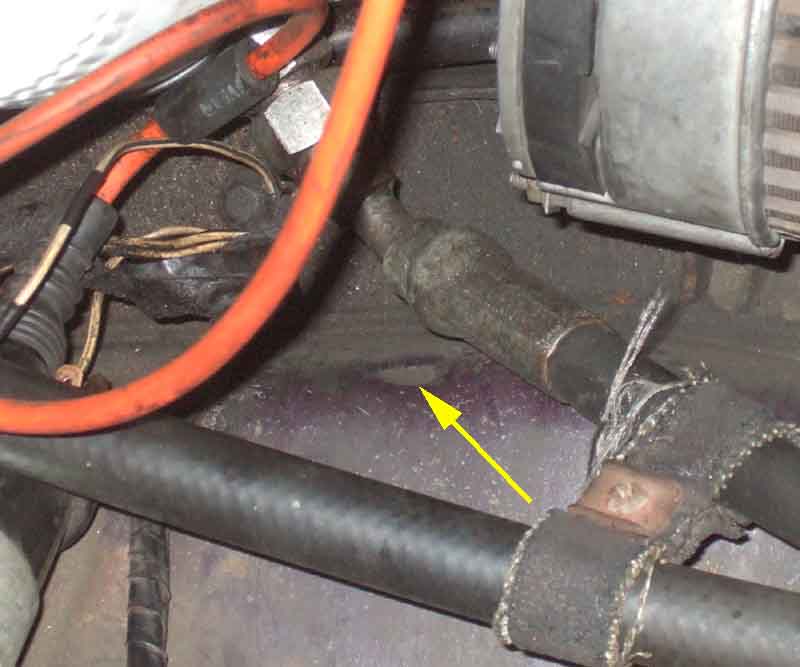 Subsequently I noticed a depression in the inner wing, free of paint and rust, which looks like the oil hose elbow has been rubbing or hitting it, even though I've never been aware of a knocking. The elbow is well clear of it now, but it also raises the question of just what angle the filter head should be wrt the block. At the moment it is angled slightly backwards, which puts it close to the distributor as it was before. At right-angles, or even slightly forwards, would give more clearance to that but put the elbow closer to the alt. However that could be compensated for by adjusting the angle of the elbow.
Subsequently I noticed a depression in the inner wing, free of paint and rust, which looks like the oil hose elbow has been rubbing or hitting it, even though I've never been aware of a knocking. The elbow is well clear of it now, but it also raises the question of just what angle the filter head should be wrt the block. At the moment it is angled slightly backwards, which puts it close to the distributor as it was before. At right-angles, or even slightly forwards, would give more clearance to that but put the elbow closer to the alt. However that could be compensated for by adjusting the angle of the elbow.
 Gavin Sidey on the MGOC forum with a similar problem, but the 'grease ring test' indicated the adapter was flat unlike Bee's. However in this case after tightening the filter, then running the engine and getting oil spurting out, he was finding the filter loose, indicating perhaps it had jumped a thread. The threads are indeed very rough where the filter tightens, so he has one from Welsh MG on the way.
Gavin Sidey on the MGOC forum with a similar problem, but the 'grease ring test' indicated the adapter was flat unlike Bee's. However in this case after tightening the filter, then running the engine and getting oil spurting out, he was finding the filter loose, indicating perhaps it had jumped a thread. The threads are indeed very rough where the filter tightens, so he has one from Welsh MG on the way.


